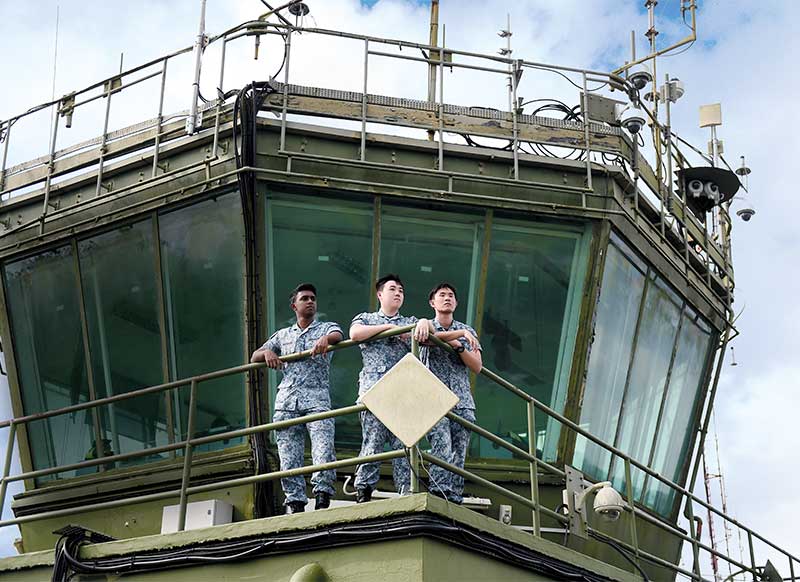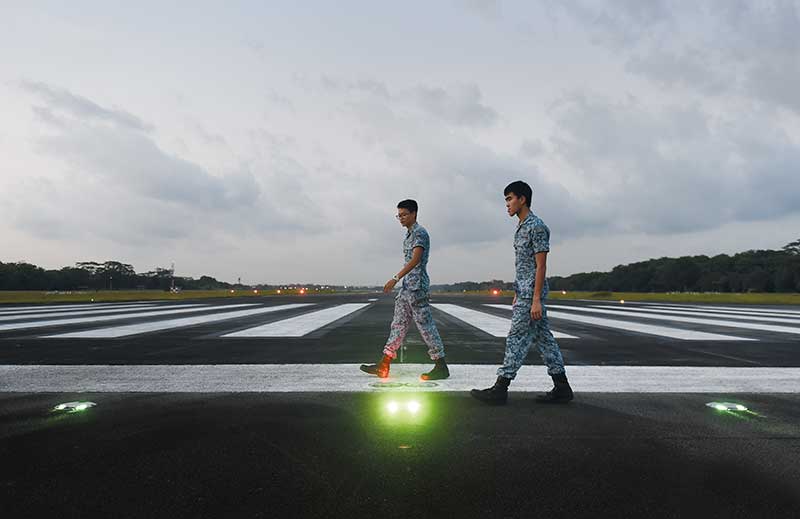OPS & TRAINING
WE HAVE CONTROL
01 Sep 2017

In the second of our three-part series on lesser-known National Service vocations, meet the boys who have a hand in the safe take-off and landing of aircraft at Tengah Air Base.
It is a few minutes from daybreak, but the boys have already been at work for the past hour. Combing the airfield at Tengah Air Base, they scrutinise every detail of the runway.
From runway lights to the leftovers of an overzealous grass cutter the day before, every detail is recorded. Wrapping at about 7:30am, this is a daily drill. The report is then sent to other units for runway maintenance.
"Airfield inspecting is just one of our multiple roles at 205 Squadron (SQN)," said Lieutenant (LTA) Seah Shao Xuan. The Full-time National Serviceman (NSF) is trained as an Air Warfare Officer (AWO) (Command, Control and Communications) (C3).
Up in the squadron's tower cupola, another group of NSFs is prepping for the day's flights.
Info flurry
Peeking out from the flat expanse of the airfield, the tower cupola offers an unobstructed 360-degree view of the runways. Here, the air traffic controller on duty dishes out, among many things, clearances for departing and arriving aircraft.
Assisting the duty controller is a Tower Information Coordinator (TIC), who is typically trained as an
Air Operations Specialist (AOS). His job is to log the flight details and supply the controller with information that comes in from all areas within the airbase.
"During training, we were, quite frankly, shocked at the level of intensity in the tower," said AOS
3rd Sergeant (3SG) Bryan Lim. At full tilt, the controller can be speaking to multiple pilots waiting to land or take off, and responding to requests for access from other units.
While listening in to the conversations between the duty controller and the pilots, a TIC has to log down details such as the time of launch and recovery, as well as technical details like landing and recovery profiles.
"For example, pilots can choose to land with the aid of their instruments when there is adverse weather and we have to catch that information to enter into the tower log," explained 3SG Preshaan Austeine s/o Subash, a TIC in 205 SQN.
Max concentration
In the midst of despatching aircraft, other units might call in with additional information such as approaching storms, runway obstructions, or simply that another unit needs to move within the airfield.
"When it has the potential to affect aircraft operations, we need to alert the duty controller quickly. Sometimes things can change in a split second," said 3SG Lim.
For this reason, each controller-TIC pair works in short bursts of about two hours at a stretch so that they can maintain a high level of alertness.
Training to be an AOS starts at the Air Force Training Command, where they go through a four-month course learning the basics of operations in the Air Force and fundamental aviation knowledge.
Then it's on to the operational squadrons, where they receive further training. It takes about eight weeks of learning on the job before a TIC is qualified to work in the tower.
Never comfortable
Others, such as 3SG Jeremy Lee, are posted to the Base Command Post (BCP) which functions like the nerve centre of the entire airbase.
"All the units within the base report any concerns they might have, which range from security to movement of assets within the base," said 3SG Lee, an AOS.
"In the BCP, there are people from different squadrons and it's where we coordinate and manage base operations together. I think we have at least five telephones to man!"
He added: "One thing about this job - we never get fully comfortable here because there's something new every day (that we have to respond to)."
Talking (war)birds down
Another dimension of an NSF's job in 205 SQN lies with the AWOs. Some of them are trained as talk-down controllers who provide landing pilots with an additional pair of eyes during bad weather.
Operating the Precision Approach Radar, the AWOs (C3) "talk" the pilots down by giving them information on their position in relation to the runway.
"This happens very quickly, in the space of about two to three minutes, as the aircraft approaches the runway," said 2nd Lieutenant (2LT) Lam Wei Boon, who is currently being trained for the role. It is the only position where NSFs communicate directly with pilots.
When asked how he felt to be serving NS in an obscure vocation, 2LT Lam said: "The satisfaction comes from being operational; as we work, we also contribute to the defence of our skies."
ALSO READ IN OPS & TRAINING

Exercise Wallaby 2025: To see better, shoot faster
31 Oct 2025
The SAF focuses on complex strike missions and multi-domain integration in Exercise Wallaby 2025, the 35th edition of its largest unilateral overseas exercise.

Ex Wallaby 25 – Greater Integration and Complexity
25 Oct 2025
The 35th edition of the SAF’s largest unilateral overseas exercise is an opportunity for expanded scale and deeper integration towards an effective, networked fighting force.

Ex Forging Sabre ramps up use of unmanned assets in integrated strike operations
12 Sep 2025
In this 10th edition of Exercise Forging Sabre, the SAF sharpened its cutting edge for the dynamic modern battlefield, with expanded integration between manned and unmanned platforms.





